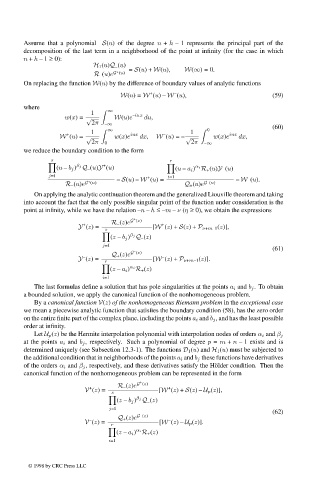Page 527 - Handbook Of Integral Equations
P. 527
Assume that a polynomial S(u) of the degree n + h – 1 represents the principal part of the
decomposition of the last term in a neighborhood of the point at infinity (for the case in which
n + h – 1 ≥ 0):
H 1 (u)Q – (u)
= S(u)+ W(u), W(∞)=0.
R – (u)e G + (u)
On replacing the function W(u) by the difference of boundary values of analytic functions
–
+
W(u)= W (u) – W (u), (59)
where
1 ∞ –iux
w(x)= √ W(u)e du,
2π –∞
0 (60)
1 ∞ 1
+ iux – iux
W (u)= √ w(x)e dx, W (u)= – √ w(x)e dx,
2π 0 2π –∞
we reduce the boundary condition to the form
s r
+
–
(u – b j ) Q – (u)Y (u) (u – a i ) R + (u)Y (u)
β j
α i
j=1 + i=1 –
– S(u) – W (u)= – W (u).
R – (u)e G + (u) Q + (u)e G – (u)
On applying the analytic continuation theorem and the generalized Liouville theorem and taking
into account the fact that the only possible singular point of the function under consideration is the
point at infinity, while we have the relation –n – h ≤ –m – ν (η ≥ 0), we obtain the expressions
+
R – (z)e G (z) +
+
Y (z)= [W (z)+ S(z)+ P ν+m–1 (z)],
s
(z – b j ) Q – (z)
β j
j=1
(61)
–
Q + (z)e G (z) –
–
Y (z)= [W (z)+ P ν+m–1 (z)].
r
(z – a i ) R + (z)
α i
i=1
The last formulas define a solution that has pole singularities at the points a i and b j . To obtain
a bounded solution, we apply the canonical function of the nonhomogeneous problem.
By a canonical function V(z) of the nonhomogeneous Riemann problem in the exceptional case
we mean a piecewise analytic function that satisfies the boundary condition (58), has the zero order
on the entire finite part of the complex plane, including the points a i and b j , and has the least possible
order at infinity.
Let U p (z) be the Hermite interpolation polynomial with interpolation nodes of orders α i and β j
at the points a i and b j , respectively. Such a polynomial of degree p = m + n – 1 exists and is
determined uniquely (see Subsection 12.3-1). The functions D 1 (u) and H 1 (u) must be subjected to
the additional condition that in neighborhoods of the points a i and b j these functions have derivatives
of the orders α i and β j , respectively, and these derivatives satisfy the H¨ older condition. Then the
canonical function of the nonhomogeneous problem can be represented in the form
+
R – (z)e G (z) +
+
V (z)= [W (z)+ S(z) – U p (z)],
s
(z – b j ) Q – (z)
β j
j=1
(62)
–
Q + (z)e G (z) –
–
V (z)= r [W (z) – U p (z)].
α i
(z – a i ) R + (z)
i=1
© 1998 by CRC Press LLC
© 1998 by CRC Press LLC
Page 509

